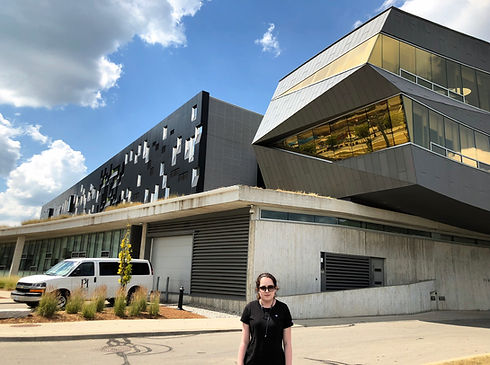
International summer school for young physicists (ISSYP)

July 2018
If you are considering a future career in physics, I highly recommend that you apply to Perimeter Institute’s International Summer School for Young Physicists (ISSYP) in Waterloo, Canada.
This summer, I spent two action-packed weeks immersed in theoretical physics at Perimeter Institute, one of the largest physics research centres in the world. We delved into fascinating topics typically shied away from in your secondary school physics class. For example, quantum mechanics, special and general relativity, gravitational waves, cosmology and black holes. A highlight was a lecture by Dr Neil Turok, the Director of Perimeter Institute, who shared his fascinating thoughts about cosmology and the birth of the universe.
ISSYP brings together 40 liked-minded secondary school students: 20 from Canada and 20 from around the globe. Unusually for a physics program, half of the students were female. We learned as much from each other, as we did from the Perimeter Institute researchers. Since we had different math backgrounds, at the beginning of the program we were given a math primer. However, ISSYP revolves around understanding the concepts, theories and ideas that underpin the theoretical physics, rather than on the heavy-duty mathematics.
My favourite experience at ISSYP was the tour of SNOLAB (Sudbury Neutrino Observatory Lab), a research laboratory located 2km below the earth’s surface specialising in sub-atomic physics, in particular neutrino and dark matter physics. In order to reach the laboratory, we descended down an active mine to the deepest clean room facility in the world. At the entrance of the mine, we were provided with coveralls, steel-toe boots and hardhats. The cage lift transported us from ground level to the mine at 10.6 meters per second (2,100 ft/min). In order to counteract the discomfort experienced in our ears caused by the change in pressure and velocity of our descent, we were given gum to chew.
Once we reached the lab, we were required to go through a thorough decontamination procedure. The procedure is necessary to maintain the high levels of cleanliness required to prevent excess radioactivity from entering the lab and interfering with the experiments. We were first required to wash our boots before entering the shower area. The shower area was divided into a “dirty area” and a “clean area,” which was separated by showers. We had to remove all our gear and leave it in the “dirty area” and take a shower before entering into the “clean area.” Once clean, we were given disposable suits and hair nets, and sanitized socks and boots to wear. The decontamination procedure felt somewhat surreal; as if I were re-enacting a scene from a sci-fi movie.
During the tour of SNOLAB we were introduced to several dark matter experiments being conducted there. One of the dark matter experiments, DAMIC (Dark Matter in CCDs) is a novel dark matter experiment that has unique sensitivity to dark matter particles with masses below 10 GeV, making the search for dark matter particles with low masses possible. We also learned about:
-
PICO-60, the world’s largest bubble chamber for dark matter detection that is currently operating two dark matter search experiments: a bubble chamber filled with ~57 kg of C3F8 and a chamber loaded with 3 kg of C3F8 and
-
DEAP-3600 (Dark matter Experiment using Argon Pulse-shape discrimination) a direct dark matter search experiment that uses liquid argon as target material. The second-generation detector contains 3,600 kg of liquid argon and is designed with a target sensitivity to spin-independent scattering on nucleons of 10-46cm2, several hundred times more sensitive than other current dark matter search experiments.
We were very privileged to have the opportunity to see these experiments in person. There are very, very few people who are not actively working on SNOLAB experiments permitted to enter the lab. Being one of the few to tour the lab and see the experiments in person was an experience of a lifetime!
The afternoons of the second week at ISSYP were dedicated to mentoring sessions. We were split into small groups to work with Perimeter Institute researchers in mentoring sessions designed to give us the opportunity to concentrate on studying a single theoretical physics problem in greater depth. In my mentoring session, we studied solid state physics, a subfield of condensed matter physics. Our mentoring sessions were incredibly insightful and engaging. I chose to study the classical Hall effect, a phenomenon in the field of material electromagnetism. At the end of the program, we presented our research in the form of a poster session to the researchers at Perimeter Institute. It was an amazing experience to have world-class researchers look at our work, ask questions and share their experiences and knowledge.
ISSYP was not all work and no play. I became friends with students as passionate about physics I am from all over the globe, including from Turkey, India, Singapore, Spain, Canada, Brazil and Sweden. There were ample opportunities to socialise and let our hair down, including a day trip to Niagara Falls, a trip to downtown Waterloo and a talent show.
If you are a young physicist planning to study physics at university and would love to spend two weeks of your summer exploring the mysteries of the universe with a group of like-minded students from around the world, I highly recommend that you apply to ISSYP. It was an out-of-this-world experience that has left me with a profound understanding of what it means to be a theoretical physicist.




Receiving a copy of his book "The Universe Within: From Quantum to Cosmos" from Dr Neil Turok, the Director of Perimeter Institute.

Standing in front of Perimeter Institute.




